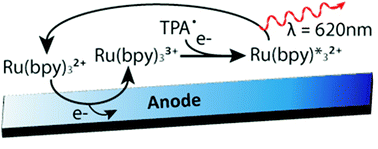Improving ruthenium-based ECL through nonionic surfactants and tertiary amines
Abstract
The influence of surfactants and coreactants on Ru(bpy)32+ electrogenerated chemiluminescence (ECL) was investigated comparatively. Specifically, the influence that the two tertiary amines, N-butyldiethanolamine (NBEA) and 2-(dibutylamino)ethanol (DBAE) have on the ECL reaction, alone and in the presence of the two surfactants Triton™ X-100 and Zonyl® FSN, was investigated, in comparison with that of the well-studied and established coreactant tripropylamine (TPA). Experiments were conducted on poly(methyl methacrylate) substrates coated with plasma-evaporated gold as used in many miniaturized systems. Upon optimization and study of the various combinations, the combination of NBEA/Zonyl FSN provided superior ECL signal characteristics. A limit of detection (LOD) of 2.2 nM Ru(bpy)32+ was obtained. Compared with the LOD of 0.59 μM for the commonly used TPA/Triton™ X-100 system, the resulting LOD is enhanced by a factor of 250. In addition, significantly more stable signals lead to an increase in sensitivity by a factor of 50. This makes the NBEA/Zonyl® FSN system an attractive ECL strategy, especially for miniaturized analytical systems. Furthermore, it became clear that previously postulated effects of surfactants on the enhancement of coreactant-based ECL do not translate to other surfactants and coreactants. We could demonstrate that more complicated mechanisms are at play as the ECL intensity for Ru(bpy)32+/NBEA was the highest in the presence of Zonyl® FSN, whereas the ECL signal decreased significantly upon introduction of the surfactant with DBAE as coreactant.



 Please wait while we load your content...
Please wait while we load your content...